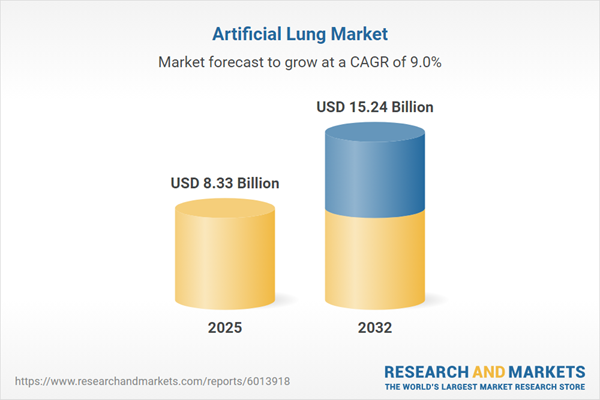Speak directly to the analyst to clarify any post sales queries you may have.
The artificial lung market is progressing as healthcare stakeholders and suppliers adapt to evolving clinical demands and technology innovations. Senior decision-makers are revising operational and growth strategies to maintain relevance, drive better patient outcomes, and secure competitive positioning within a complex landscape.
Artificial Lung Market Snapshot
The artificial lung market reached USD 7.63 billion in 2024 and is expected to expand to USD 8.33 billion by 2025, with further growth projected to USD 15.24 billion by 2032. This reflects a compound annual growth rate (CAGR) of 9.02%. Market development is propelled by rapid adoption of advanced respiratory technologies in both hospital and home care settings. Continued advances in extracorporeal and implantable systems are broadening the clinical use of artificial lungs, enabling seamless integration into protocols for acute, chronic, and mobile care. This ongoing innovation positions stakeholders to differentiate solutions and establish value-driven operations across global healthcare networks.
Scope & Segmentation of the Artificial Lung Market
This analysis provides senior executives with actionable segmentation to guide high-level strategy and procurement decisions across the artificial lung sector. The following dimensions are evaluated:
- Product Types: Covers extracorporeal membrane oxygenation systems, implantable lung devices, and core components such as cannulae, oxygenators, consoles, and pumps. These products address a range of respiratory needs in emergency and ongoing care settings.
- Technologies: Reviews innovations in ceramic, hollow fiber, and flat sheet membranes, alongside polyethersulfone and polypropylene materials. These advances contribute to improved device performance and support compliance with regulatory standards.
- End Users: Examines adoption trends in hospitals, ambulatory surgical centers, and home care organizations, highlighting the increasing preference for adaptable respiratory support within modern care delivery models.
- Applications: Considers use cases in intensive care units, long-term patient support, and emergency transport, demonstrating the broad versatility of artificial lung solutions.
- Distribution Channels: Assesses procurement via direct manufacturer agreements, supplier relationships, and online platforms, addressing strategies for risk mitigation and continuity.
- Material Types: Investigates the use of polyethersulfone, polypropylene, and silicone in device manufacturing, underscoring their impact on quality, cost, and compliance efficiency.
- Regions: Evaluates opportunities and challenges across the Americas, Europe, Middle East & Africa, and Asia-Pacific. Special focus is given to infrastructure development, localized market access, and unique regulatory environments.
- Key Companies: Profiles leading industry players, including Getinge AB, LivaNova PLC, Medtronic PLC, Terumo Corporation, Fresenius Medical Care AG & Co. KGaA, MC3 Cardiopulmonary Support Inc., SynCardia Systems LLC, ALung Technologies Inc., Aeson Cardiovascular AG, and Hemovent GmbH, to support partnership assessment and competitive analysis.
Key Takeaways for Artificial Lung Market Decision-Makers
- Innovation in membrane technology is enabling the development of more compact artificial lung devices, expanding their suitability for home care and mobile solutions.
- Closer collaboration between regulatory authorities and industry stakeholders is accelerating the integration of new devices into existing clinical workflows.
- Digital interfaces combined with advanced analytics are improving usability and monitoring, empowering providers to personalize therapy and make data-driven decisions in real time.
- Careful material selection is fundamental to optimizing device longevity, managing costs, and simplifying regulatory approvals during procurement.
- Regional market strategies should be tailored to local infrastructure capabilities and compliance needs, in order to maximize adoption and mitigate entry challenges.
- Robust, flexible supply chain strategies are indispensable for adapting to market and regulatory uncertainties, supporting business continuity amid evolving risks.
Tariff Impact on Supply Chain Resilience
Forthcoming U.S. tariffs on artificial lung components imported from Asia are influencing how companies design their supply chain strategies. Industry leaders are moving toward near-shoring and developing regional partnerships to protect product supply and address increasing operational expenses. These adaptive sourcing approaches are vital for ensuring consistent availability and stability throughout periods of regulatory change.
Methodology & Data Sources
Research findings are based on direct input from clinicians, biomedical engineers, procurement experts, and regulatory professionals. The analysis draws from clinical trial outcomes, patent filings, and regulatory documentation to ensure the content is both actionable and evidence-based for all market stakeholders.
Why This Report Matters to Market Stakeholders
- Equips executive teams to optimize resources and refine strategy as artificial lung market dynamics and supply networks evolve.
- Assists procurement and R&D leaders in identifying and managing operational, sourcing, and compliance challenges amid global shifts.
- Provides actionable insights for aligning technology investment decisions with emerging trends and care delivery requirements.
Conclusion
This analysis offers clear, strategic guidance to help decision-makers navigate the evolving artificial lung market. Alignment among key stakeholders supports effective adaptation and continued advancement in respiratory care solutions.
Additional Product Information:
- Purchase of this report includes 1 year online access with quarterly updates.
- This report can be updated on request. Please contact our Customer Experience team using the Ask a Question widget on our website.
Table of Contents
3. Executive Summary
4. Market Overview
7. Cumulative Impact of Artificial Intelligence 2025
Companies Mentioned
The companies profiled in this Artificial Lung market report include:- Getinge AB
- LivaNova PLC
- Medtronic PLC
- Terumo Corporation
- Fresenius Medical Care AG & Co. KGaA
- MC3 Cardiopulmonary Support Inc.
- SynCardia Systems, LLC
- ALung Technologies, Inc.
- Aeson Cardiovascular AG
- Hemovent GmbH
Table Information
| Report Attribute | Details |
|---|---|
| No. of Pages | 185 |
| Published | October 2025 |
| Forecast Period | 2025 - 2032 |
| Estimated Market Value ( USD | $ 8.33 Billion |
| Forecasted Market Value ( USD | $ 15.24 Billion |
| Compound Annual Growth Rate | 9.0% |
| Regions Covered | Global |
| No. of Companies Mentioned | 11 |









